Pool fitness
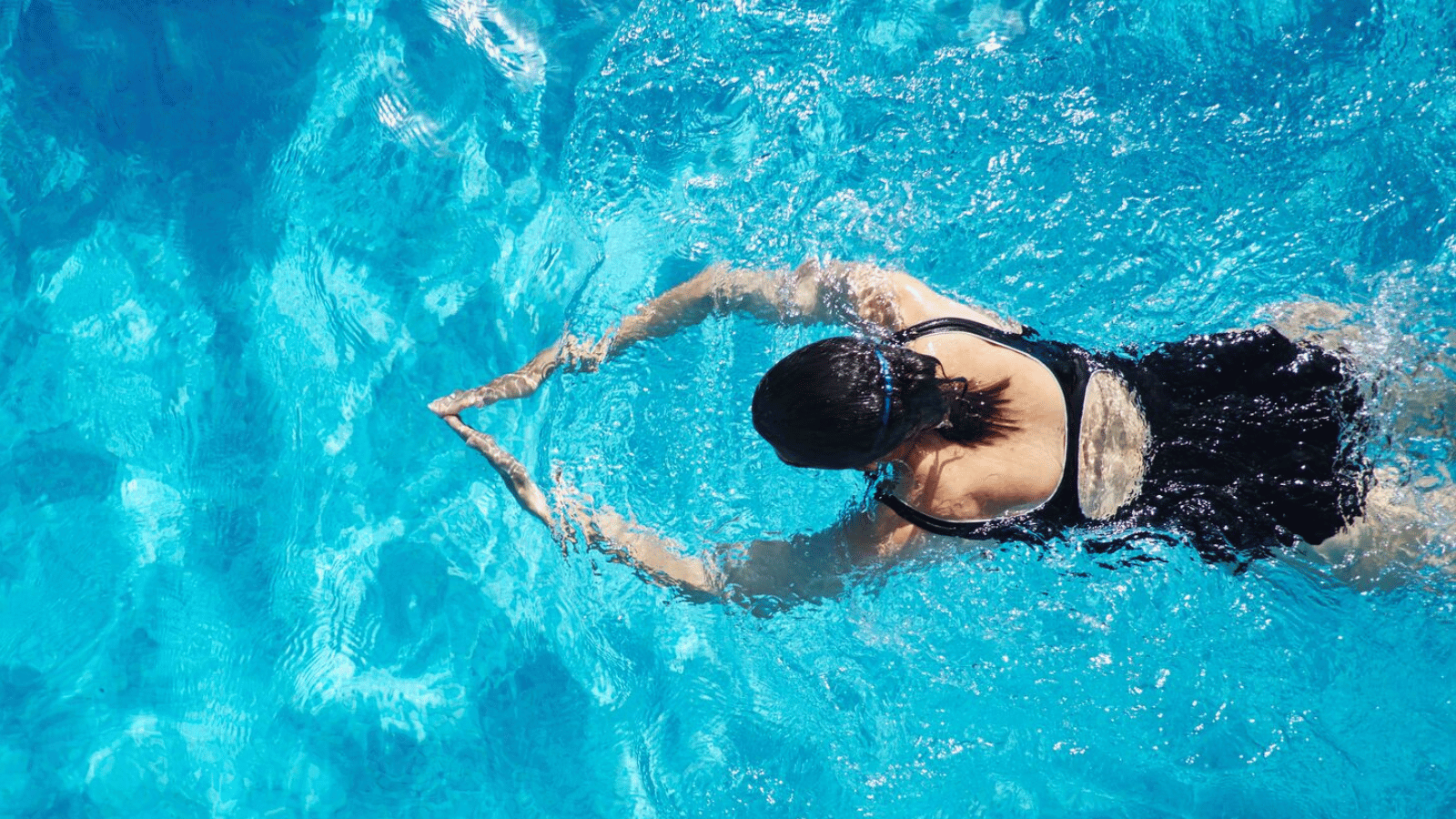

Swimming exercise
Activity in the pool is an excellent way to build your aerobic fitness and mix up your routine. The low impact of most aquatic exercise means that weight and joint injuries that may limit you on land are negated by buoyancy. So, you can push yourself harder without overloading your joints.
Water has a greater viscosity than air (i.e. it is harder to move through), which can be used to your advantage to create resistance exercises with simple movements and requires minimal, if any, equipment. Another benefit of being submerged in water is that it places hydrostatic pressure on the body. This means that your heart rate and blood pressure decrease during a given activity, so you can work harder than you can on land.
Taking your training into the pool is also a terrific way to beat the heat, and a workout here may be the ideal solution if you struggle with heat stress. Finally, variety is the spice of life when it comes to exercise, so by implementing laps, deep-water running or hydro-resistance training into your regime, you may just develop a winning formula.
What to wear: First, wear something you feel comfortable in. For women, we recommend a one piece and, for the guys, cossies/compression style shorts or swim shorts. Goggles are a must for swimming laps. Finding a pair that works for you makes a world of difference; having a leaky pair will cause frustration. Also if you have long hair, grab a swim cap, as it will make a difference to your comfort and performance in laps.
Equipment: You can do a ton of exercises in the pool with no equipment, but if you’re going to really get into it you might want to get the following:
- Goggles
- Foam dumbbells
- Pool noodle
Tips
- It’s important to know your limitations as it can be unnerving to be out of your depth. The number one safety message is not to go in deep water until you are confident.
- Check the depth before you dive in.
- Check pool rules and timetables before entering (especially swimming lanes).
- Stay hydrated.
- Get a lesson or two in technique.
1. Hydro star jumps
Water depth: Chest
Muscles: Glutes, adductors, shoulders, upper back.
Technique: Just like a normal star jump, stand tall with your hands flat on the side of your legs with your thumbs facing forwards, then jump your feet wide and raise your hands to just under the surface (which should be just above shoulder height in your wide stance). Then jump back to your starting position. See how many you can do in 40 seconds. To make it harder, hold foam dumbbells.
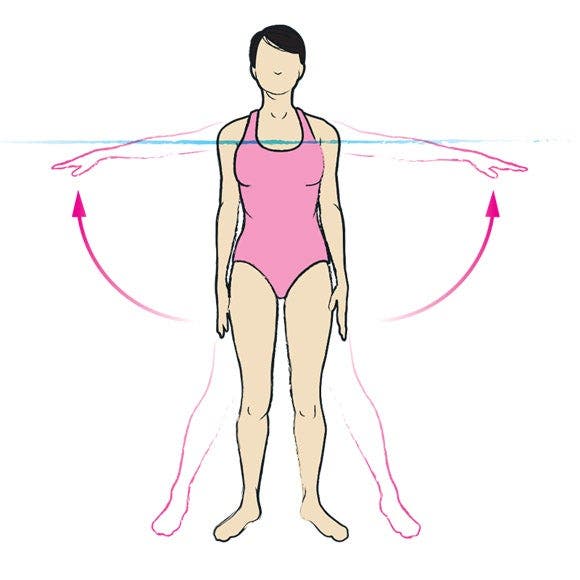
2. Horizontal flyes
Water depth: Just above shoulders
Muscles: Chest, upper back, core.
Technique: Stand tall with good posture and your arms straight out to the side, palms facing forwards and fingers together. Slightly bend your knees for balance, now bring your hands together in front of you at chest height, then as soon as they touch, swing your arms back as far as you comfortably can. Repeat. You need to engage your core and keep your knees bent to ensure you don’t fall back or forwards during the movement. See how many you can do in 40 seconds. To make it harder, hold foam dumbbells.
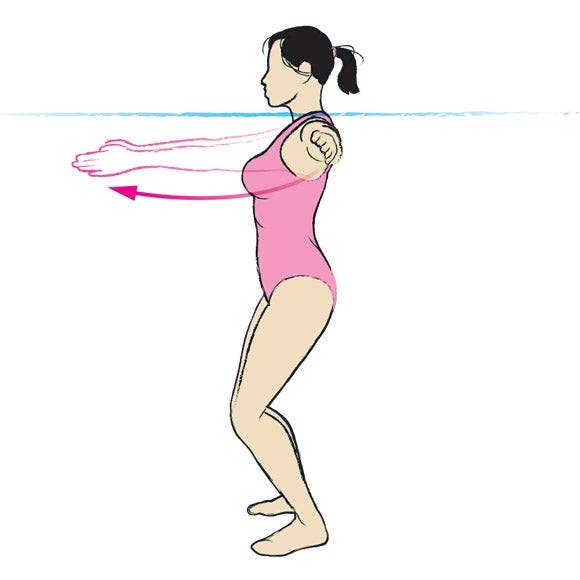
3. Waist-deep
Water depth: Waist deep (or chest deep)
Muscles: Legs, glutes, arms and core.
Technique: Start standing tall in waist-deep water, then lean forwards and run as fast as you can with short steps for 40 seconds. If the water gets too deep, turn around and keep going back to where you started. The main thing is that you are working hard for 40 seconds, so don’t worry about slight changes in water depth.
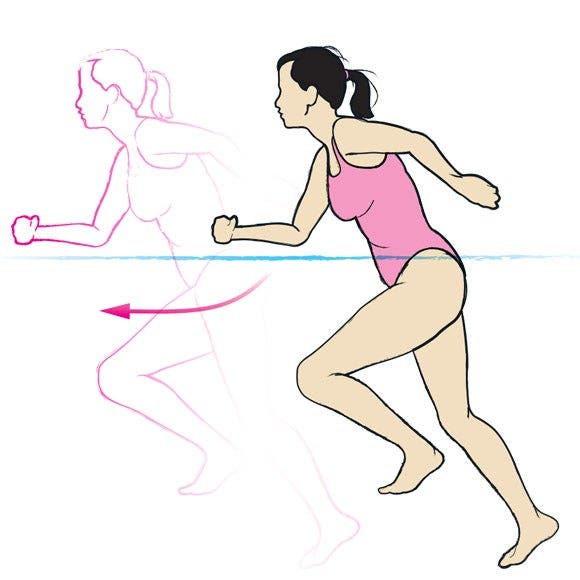
4. Rotating lunge jumps
Water depth: Waist deep
Muscles: Legs, glutes and core.
Technique: Start in a split lunge position, with your right leg forward and foot flat on the bottom of the pool, and your left leg behind you up on your toe. Tuck elbows into your sides with your lower arms at 90º and hands flat together so your fingers point ahead. Jump and swap legs so your left leg is forward and rotate your upper body so that your hands are pointing to the left, then jump and swap again so your right foot is forward and your hands and upper body are facing to the right. See how many you can do in 40 seconds.
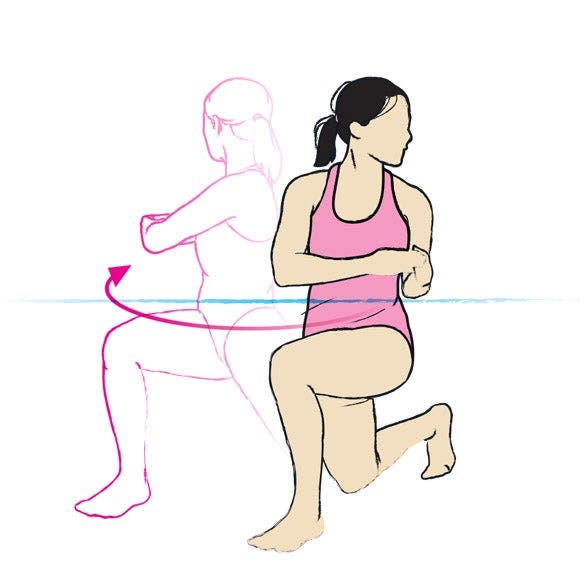
Pool programs to take your activity to the next level...
New to swimming or activity
Goal: To develop swimming distance, improve aerobic fitness and improve body strength.
Laps: Start slow and focus on technique. Do one lap then take a short rest and move onto the next lap when you feel ready. See how many you can complete in 30 minutes. Slowly try to build to two non-stop laps, then three laps, until you can continuously swim slowly for 30 minutes.
Post-lap exercises x 2
| Exercise | Times & Reps | Rest |
|---|---|---|
| Hydro star jumps | 40 secs | 20 secs |
| Horizontal flyes | 40 secs | 20 secs |
| Waist-deep running | 40 secs | 20 secs |
Already swimming
Goal: To further increase swimming speed and endurance, improve aerobic fitness and full body strength.
Laps: Swim 30 minutes of laps with the goal of completing your maximum distance/number of laps. Start slow and try to build your distance every time you go to the pool until you are breaking world records! Take rests if necessary, but try to go non-stop.
Post-lap exercises x 3
| Exercise | Time & Reps | Rest |
|---|---|---|
| Hydro star Jumps | 40 secs + 50m fast swim | 20 secs |
| Horizontal flyes | 40 secs + 50m fast swim | 20 secs |
| Waist-deep running | 40 secs + 50m fast swim | 20 secs |
| Rotating lunge jumps | 40 secs + 50m fast swim | 20 secs |
